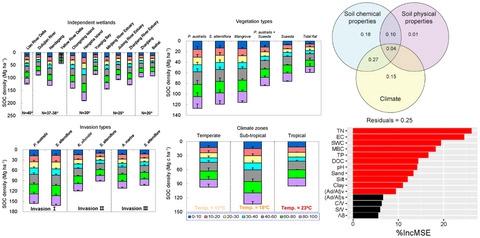当前位置:
X-MOL 学术
›
Glob. Change Biol.
›
论文详情
Our official English website, www.x-mol.net, welcomes your feedback! (Note: you will need to create a separate account there.)
Storage, patterns and influencing factors for soil organic carbon in coastal wetlands of China
Global Change Biology ( IF 11.6 ) Pub Date : 2022-06-30 , DOI: 10.1111/gcb.16325 Shaopan Xia 1, 2 , Zhaoliang Song 2, 3 , Lukas Van Zwieten 4 , Laodong Guo 5 , Changxun Yu 6 , Weiqi Wang 7 , Qiang Li 2 , Iain P Hartley 8 , Yuanhe Yang 9 , Hongyan Liu 10 , Yidong Wang 11 , Xiangbin Ran 12 , Cong-Qiang Liu 2, 3 , Hailong Wang 13, 14
Global Change Biology ( IF 11.6 ) Pub Date : 2022-06-30 , DOI: 10.1111/gcb.16325 Shaopan Xia 1, 2 , Zhaoliang Song 2, 3 , Lukas Van Zwieten 4 , Laodong Guo 5 , Changxun Yu 6 , Weiqi Wang 7 , Qiang Li 2 , Iain P Hartley 8 , Yuanhe Yang 9 , Hongyan Liu 10 , Yidong Wang 11 , Xiangbin Ran 12 , Cong-Qiang Liu 2, 3 , Hailong Wang 13, 14
Affiliation

|
Soil organic carbon (SOC) in coastal wetlands, also known as “blue C,” is an essential component of the global C cycles. To gain a detailed insight into blue C storage and controlling factors, we studied 142 sites across ca. 5000 km of coastal wetlands, covering temperate, subtropical, and tropical climates in China. The wetlands represented six vegetation types (Phragmites australis, mixed of P. australis and Suaeda, single Suaeda, Spartina alterniflora, mangrove [Kandelia obovata and Avicennia marina], tidal flat) and three vegetation types invaded by S. alterniflora (P. australis, K. obovata, A. marina). Our results revealed large spatial heterogeneity in SOC density of the top 1-m ranging 40–200 Mg C ha−1, with higher values in mid-latitude regions (25–30° N) compared with those in both low- (20°N) and high-latitude (38–40°N) regions. Vegetation type influenced SOC density, with P. australis and S. alterniflora having the largest SOC density, followed by mangrove, mixed P. australis and Suaeda, single Suaeda and tidal flat. SOC density increased by 6.25 Mg ha−1 following S. alterniflora invasion into P. australis community but decreased by 28.56 and 8.17 Mg ha−1 following invasion into K. obovata and A. marina communities. Based on field measurements and published literature, we calculated a total inventory of 57 × 106 Mg C in the top 1-m soil across China's coastal wetlands. Edaphic variables controlled SOC content, with soil chemical properties explaining the largest variance in SOC content. Climate did not control SOC content but had a strong interactive effect with edaphic variables. Plant biomass and quality traits were a minor contributor in regulating SOC content, highlighting the importance of quantity and quality of OC inputs and the balance between production and degradation within the coastal wetlands. These findings provide new insights into blue C stabilization mechanisms and sequestration capacity in coastal wetlands.
更新日期:2022-06-30



























 京公网安备 11010802027423号
京公网安备 11010802027423号